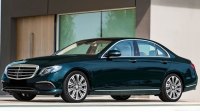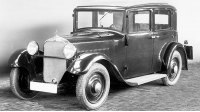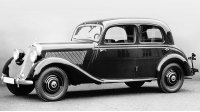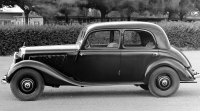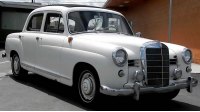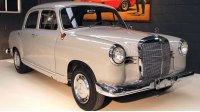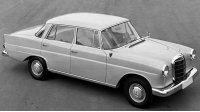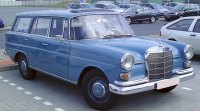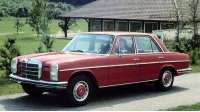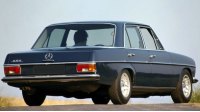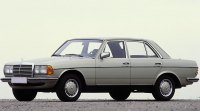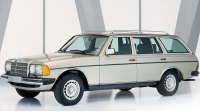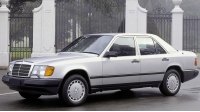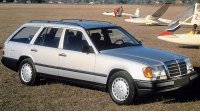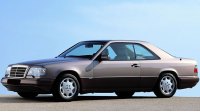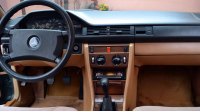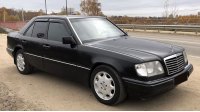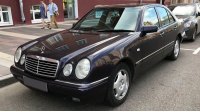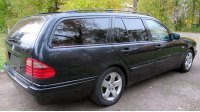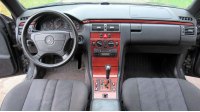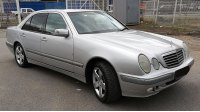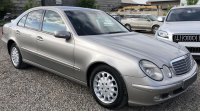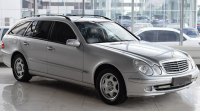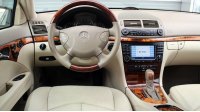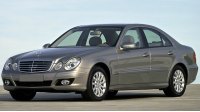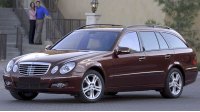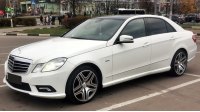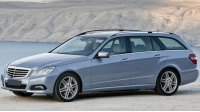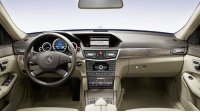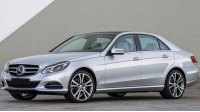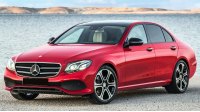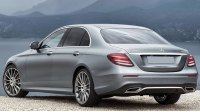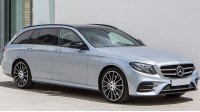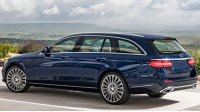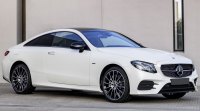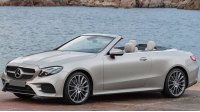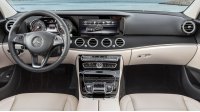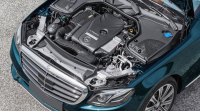Pre-1993 prefix «E» meant Einspritzung (fuel injection, german), and after all the company's cars began to use injection and the name «E-class» became distinct from this word. The engine is located in the front transverse, rear-wheel drive or four-wheel drive (4MATIC). The body was produced in the form of a sedan, station wagon, coupe and convertible. Cars are the main competitors Audi A6, BMW 5 series, Chrysler 300C, Honda Crosstour, Infiniti M, Nissan Teana, Peugeot 607, Toyota Camry and Volvo S90.
E-class predecessors
W15 (1931−1936)
Mercedes-Benz W15 «Typ 170» - mid-size family car, available as a sedan or convertible with four doors (length 3940 mm, width 1630 mm, height 1650 mm). 1.7 liter engine (1692 cm3, M15, 32 hp) with six cylinders arranged in a row, installed longitudinally in front. Power was sent to the rear wheels via a four-speed manual gearbox. The motor had water cooling and a separate lubrication system. Consumption was 11 liters per 100 kilometers.
It was presented at the Paris Motor Show in October 1931. It was positioned as a compact and lightweight car, standing out from the line of expensive and large cars that were mainly produced by Mercedes-Benz at that time. For all the time, more than 13 thousand units were produced.
W136 (1935−1955)
Mercedes-Benz W136 «170 V» - a mid-size family car, produced from 1935 to 1942 and from 1947 to 1955. A break in production occurred due to the Second World War. During these periods, about 160 thousand cars were produced and this was the most popular model of the company. The body was produced in the following variations - 4-door: sedan, convertible limousine and van; 2-door: convertible, roadster and pickup. The length of the car was 4270 mm, width 1570 mm and 1630 mm (since 1950). Assembly was carried out in Germany and Argentina.
The engine was located longitudinally in front, the drive was to the rear wheels through a four-speed gearbox. At first, the gasoline engine was the same volume as its predecessor - 1.7 liters, but it was a four-cylinder (M136) and had more power - 37 hp. At the same time, consumption was reduced to 10 liters per 100 km. Since 1950, the engine volume has been increased to 1.8 liters (1767 cm3), power was 52 hp. There were also 1.7 liter diesel engines (1697 cm3, OM636, I4, 38 hp) and 1.8 liters (1767 cm3, OM636, I4, 39 hp).
In 1950, 1952 and 1953, the car underwent significant updates that affected body styles, appearance, chassis and engines.
W120, W121 (1953–1962)
Mercedes-Benz W120 «180» And W121 «190» mid-size executive cars produced from 1953 to 1962. Due to the use of new and very different bodies from their predecessors, they were called «pontoons» (Pontons). The body was only a 4-door sedan (length 4485 mm, width 1740 mm, height 1560 mm). The engine was located in front longitudinally, the transmission of torque to the rear wheels. During the release of the model, the car changed a lot both externally and mechanically. In total, about 440 thousand units were produced. Assembly was carried out in Australia, Germany and South Africa.
On «W120» installed gasoline engines of the following characteristics - 1.8 liters (1767 cm3, M136, I4, 55 hp) and 1.9 liters (1897 cm3, M121, I4, 75 hp). 1.8 liter diesel engines were also installed (1767 cm3, OM636, I4, 43 hp) and 1.9 liters (1897 cm3, OM621, I4, 47 hp).
On «W121» installed 1.9-liter gasoline engines (1897 cm3, M121, I4, 75 hp), as well as 1.9 liter diesel engines (1897 cm3, OM621, I4, 50 hp).
W110 (1961–1968)
Mercedes-Benz W110 - a mid-size executive car produced from 1961 to 1968. Models of the first series (1961-1965) were called «190c» And «190Dc», second series (1965-1968) — «200», «200D» And «230». Letter «D» in the name stands for diesel engine. The motor was located longitudinally in front, rear-wheel drive. The body was in the form of a 4-door sedan (length 4680 mm, width 1770 mm, height 1440 mm) and since 1965 they began to produce a 5-door station wagon. About 630 thousand cars were produced. Assembly facilities were located in Australia, Venezuela and Germany.
On «190c» installed a 1.9-liter gasoline engine (1897 cm3, M121, I4, 80 hp), on «190Dc» was a 2.0 liter diesel (1988 cm3, OM621, I4, 54 hp), on «200» was a 2.0 liter petrol engine (1988 cm3, M121, I4, 95 hp), on «230» was a 2.3 liter petrol engine (2307 cm3, M180, I4, 80 hp) and model «200D» equipped with a 2.0 liter diesel (1988 cm3, OM621, I4, 54 hp).
W114, W115 (1968–1976)
Mercedes-Benz W114 and W115 - medium-sized business class cars that were produced from 1968 to 1976. Models «W115» equipped with four-cylinder engines and were called as «200», «220», «230» And «240», while the model «W114» equipped with six-cylinder engines and had the names «230», «250» And «280». The design was developed by French automotive designer Paul Braque, who applied a three-block scheme that divides the car into three blocks - for the engine, for passengers and for luggage. The body was in the form of a 4-door sedan (length 4680 mm) or limousine (length 5330 mm), as well as a 2-door coupe. The width of the body was 1772 mm, height 1441 mm. The engine was located in front longitudinally with rear-wheel drive. In total, more than 1.9 million vehicles were produced. Assembly was carried out in Germany, Argentina, Venezuela, Portugal and South Africa.
per model «W114» installed six-cylinder gasoline engines of the following characteristics - 2.3 liters (2292 cm3, M180, I6, 120 hp), 2.5 liters (2496 cm3, M114 and M130, I6, 130 hp), 2.5 liters (2496 cm3, M114, injector, I6, 150 hp), 2.8 liters (2778 cm3, M130, I6, 130 and 140 hp), 2.8 liters (2746 cm3, M110, I6, 160 hp) and 2.8 liters (2746 cm3, M110, injector, I6, 185 hp).
per model «W115» installed gasoline and diesel four-cylinder engines. Gasoline had the following characteristics - 2.0 liters (1988 cm3, M115, I4, 95 hp), 2.2 liters (2197 cm3, M115, I4, 105 hp) and 2.3 liters (2307 cm3, M115, I4, 110 hp). Diesel engines were of the following volumes - 2.0 liters (1988 cm3, OM615, I4, 55 hp), 2.2 liters (2197 cm3, OM615, I4, 60 hp), 2.4 liters (2404 cm3, OM616, I4, 65 hp) and 3.0 liters (3005 cm3, OM617, I4, 80 hp).
Cars of this generation were highly reliable. Model «240D» 1976 issue is in the Mercedes-Benz Museum with a mileage of 4.6 million kilometers. In 1969, the company first used the fully electronic Bosch D-Jetronic injection system, which was installed on the model «250CE» with a coupe. In 1973, this generation was updated, which affected the appearance, new options for comfort, improved passenger safety, and new engines appeared.
W123 (1976–1986)
Mercedes-Benz W123 - German executive car, produced from 1976 to 1986. During this period, about 2.7 million vehicles were produced. As usual, the model names were associated with the volume and type of engine, as well as the type of chassis. Letter «E» in the model name stands for fuel injection, «D» - diesel engine, «Turbo» - turbocharged diesel «T» - station wagon body «C» - coupe-type body. Model code «W123» means sedan, «S123» - station wagon «C123» — coupe, «V123» - extended wheelbase (limousine) And «F123» - Chassis for ambulances and other services. The length of the sedan was 4725 mm, the coupe 4640 mm, the limousine 5355 mm. The width of the body was 1784 mm, height 1435 mm. The weight of the car was 1625 kg. The engine was longitudinally front, the drive was only on the rear wheels. Assembly shops were located in Germany, China and South Africa.
The range of gasoline engines included the following models - 2.0 liters (1988 cm3, M115, I4, 93 hp), 2.0 liters (1997 cm3, M102, I4, 108 hp), 2.3 liters (2307 cm3, M115, I4, 108 hp), 2.3 liters (2299 cm3, M102, I4, 134 hp), 2.5 liters (2525 cm3, M123, I6, 127 and 140 hp) and 2.8 liters (2746 cm3, M110, I6, 154, 175 and 182 hp). Diesel engines were of the following characteristics - 2.0 liters (1988 cm3, OM615, I4, 54 hp), 2.2 liters (2197 cm3, OM615, I4, 59 hp), 2.4 liters (2404 cm3, OM616, I4, 64 and 71 hp), 3.0 liters (2998 cm3, OM617, I5, 79 and 87 hp), 3.0 liters (2998 cm3, OM617 A, I5, turbodiesel, 123 hp). Transmission was 4 and 5 speed manual or 4 speed automatic «722.1» or «4G-TRONIC».
W124 (1984–1993)
Mercedes-Benz W123 - a mid-size executive car produced in Germany from 1984 to 1995. In 1993, the name first appeared «E-Class» and from this year begins the first generation of this model. Presented at the Seville Motor Show (Spain) November 26, 1984, and since January 1985, sales began. The design was developed in 1980-1981 under the guidance of Italian automotive designer Bruno Sacco. In 1982, the first prototype appeared, and in March 1984, testing of experimental models began. Sedan Drag Coefficient (C x) at that time was one of the best in the world and equaled 0.28. The car was assembled in Germany, India, Indonesia, Malaysia, Mexico, Poland and South Africa.
The body of the car was produced as a 4-door sedan (length 4755 mm, height 1430 mm), 5-door station wagon (length 4780 mm, height 1519 mm), 6 door limousine (length 5540 mm, height 1481 mm), 2-door coupe (length 4671 mm, height 1410 mm) and convertible (length 4671 mm, height 1392 mm). The width of the car was 1740 mm. At the Frankfurt Motor Show in September 1985, a station wagon was shown (S124). At the Geneva Motor Show in March 1987, a coupe body was shown (C124). In 1992, the first convertible appeared (A124). The engine was located longitudinally in front, the drive was on the rear wheels, and in 1987 the 4MATIC all-wheel drive system first appeared.
The car was equipped with gasoline engines of the following characteristics - 2.0 liters (1998 cm3, M111, I4, 136 hp), 2.0 liters (1997 cm3, M102, I4, 109 and 122 hp), 2.2 liters (2199 cm3, M111, I4, 150 hp), 2.3 liters (2299 cm3, M102, I4, 132 hp), 2.6 liters (2597 cm3, M103, I6, 158 hp), 2.8 liters (2746 cm3, M104, I6, 193 hp), 3.0 liters (2960 cm3, M103, I6, 177 hp), 3.0 liters (2960 cm3, M104, I6, 217 hp), 3.2 liters (3199 cm3, M104, I6, 231 hp), 4.2 liters (4196 cm3, M119, V8, 275 hp), 5.0 liters (4973 cm3, M119, V8, 322 hp) and 6.0 liters (see3, M119, V8, 376 hp).
The range of diesel engines is as follows - 2.0 liters (1997 cm3, OM601, I4, 72 hp), 2.5 liters (2497 cm3, OM602, I5, 90 hp), 2.5 liters (2497 cm3, OM602, I5, turbo, 122 hp), 2.5 liters (2497 cm3, OM605, i5, 111 hp), 3.0 liters (2996 cm3, OM603, I6, 109 hp), 3.0 liters (2996 cm3, OM606, I6, 134 hp) and 3.0 liters (2996 cm3, OM603, I6, turbo, 143 hp). Gearboxes were offered as follows - 4 and 5-speed mechanics, 4-speed automatic «4G-TRONIC» and 5 speed automatic «722.5».
In September 1989, the car underwent a restyling, mainly the appearance and interior design were affected.
First generation (W124, 1993−1995)
In 1993, the car was also restyled. Diesel engines were upgraded, and the car officially became known as «E-Class». Letter «E» in the model designation began to be placed at the beginning of the number, for example «E 200», «E 220», «E 280», «E 320». The body designation letters have been abolished, as well as the letter «D», denoting a diesel engine is replaced by the inscription «DIESEL» And «TURBODIESEL». The appearance of the car has also undergone some changes.
Sedans were produced until 1995, wagon and coupe until 1996, and convertible until 1997. Over the 11-year period of the modification's life «W124» more than 2.5 million cars were produced.
Second generation (W210, 1996−2002)
Development «W210» started in 1988. The exterior design of the W210 E-Class, designed by British car designer Steve Mattin under designer Bruno Sacco between 1989 and 1991, marked a new design concept for Mercedes. The most important thing that catches the eye is the twin oval headlights that defined the look of the model for two generations. The new design was presented at the Geneva Motor Show in March 1993. The body was produced as a 4-door sedan (W210) and 5-door station wagon (S210). The length of the car was 4818 mm, width 1798 mm, height 1417 mm. The engine was located longitudinally in front, rear-wheel drive or all-wheel drive option. Over the entire period, more than 1.6 million vehicles were produced. Assembly facilities were located in Germany, Austria, Egypt, India and Mexico.
The line of gasoline engines are the following models - 2.0 liters (1998 cm3, M111, I4, 134, 150 and 161 hp), 2.3 liters (2295 cm3, M111, I4, 148 and 194 hp), 2.6 liters (2597 cm3, M112, V6, 168 hp), 2.8 liters (2799 cm3, M112, V6, 201 hp), 2.8 liters (2799 cm3, M104, I6, 190 hp), 3.2 liters (3199 cm3, M104, I6, 217 hp), 3.2 liters (3199 cm3, M112, V6, 221 hp), 4.2 liters (4196 cm3, M119, V8, 286 hp) and 4.3 liters (4266 cm3, M113, V8, 275 hp).
The range of diesel engines is as follows - 2.0 liters (1997 cm3, OM604, I4, 87 hp), 2.2 liters (2155 cm3, OM604, I4, 94 hp), 2.2 liters (2148 cm3, OM611, I4, 101, 114, 123, 134 and 141 hp), 2.5 liters (2497 cm3, OM605, I5, 111 hp), 2.5 liters (2497 cm3, OM605, I5, turbo, 148 hp), 2.7 liters (2685 cm3, OM612, I5, 161 and 168 hp), 2.9 liters (2874 cm3, OM602, I5, 127 hp), 3.0 liters (2996 cm3, OM606, I6, 134 and 175 hp) and 3.2 liters (3222 cm3, OM613, I6, 194 hp). Gearboxes offered four models - 5 or 6-speed manual, 4-speed automatic «4G-Tronic» (722.3) and 5 speed automatic «5G-Tronic» (722.6).
In 1999, the car underwent a significant restyling, which affected about 1800 elements. The appearance of the car has changed - the hood, headlights and taillights, bumpers and exterior mirrors. The interior has also undergone changes - there was an on-board computer screen, audio control buttons, telephone and navigator on the steering wheel. On the automatic transmission, it became possible to shift gears manually. ESP function became standard (electronic stability control).

Third generation (W211, 2003−2009)
Development of the third generation began in 1997. The development ended in 2001 at a cost of about 2 billion euros. At the European Motor Show in Brussels in January 2002, the car was presented to the public. The body was in the form of a 4-door sedan (length 4818-4851 mm, width 1811-1821 mm, height 1448-1483 mm) and 5-door station wagon (length 4869-4884 mm, width 1811-1821 mm, height 1496-1506 mm). The engine was located longitudinally in front, rear-wheel drive or all-wheel drive (4Matic). The car was offered in three trim levels - Classic, Elegance and Avantgarde. For all the time, about 1.5 million cars were produced. In 2006, the 10 millionth E-Class was produced. Assembly was carried out in Germany, Austria, Egypt, Indonesia, Iran, China, Malaysia and Mexico.
The range of gasoline engines is as follows - 1.8 liters (1796 cm3, M271 E18ML, I4, 161 and 181 hp), 2.5 liters (2496 cm3, M272 E25, V6, 201 hp), 2.6 liters (2597 cm3, M112 E26, V6, 175 hp), 3.0 liters (2996 cm3, M272 E30, V6, 228 hp), 3.2 liters (3199 cm3, M112 E32, V6, 218 hp), 3.5 liters (3498 cm3, M272 E35, V6, 268 and 288 hp), 5.0 liters (4966 cm3, M113 E50, V8, 302 hp) and 5.5 liters (5461 cm3, M273 E55, V8, 380 hp).
Diesel engines were installed with the following characteristics - 2.2 liters (2148 cm3, OM646 DE 22 LA, I4, 100, 120, 134, 150 and 170 hp), 2.7 liters (2685 cm3, OM647 DE 27 LA, I5, 175 hp), 3.0 liters (2987 cm3, OM642 DE 30 LA, V6, 190, 208, 210 and 221 hp), 3.2 liters (3222 cm3, OM648 DE 32 LA, I6, 201 hp) and 4.0 liters (3996 cm3, OM628 DE 40 LA, V8, 260 and 310 hp). Gearboxes were three models - 6-speed mechanics, 5-speed automatic «5G-Tronic» and 7 speed automatic «7G-Tronic».
For a comfortable and safe ride, the Sensotronic Brake Control electro-hydraulic braking system was installed (SBC), air suspension AIRMATIC DC, multi-contour seats that are brought to a safe state in critical situations.
In 2006, the car was restyled, which was presented on April 12 at the New York International Auto Show. We slightly changed the external design and increased the dimensions of the car, minor flaws and shortcomings were corrected, new options appeared. The PRE-SAFE passenger and driver protection technology has appeared, which has already proven itself in S-class and replacing SBC, headrests with NECK-PRO technology, a tire pressure monitor and flashing brake lights.
The safety of the car was ensured by two-stage airbags for the front seats, side airbags and curtains on the windows. To control the road in the base were the ESP, ASR and ABS systems. The 2002 model passed crash tests in the European committee Euro NCAP, you can see the results in the table. US National Highway Traffic Safety Administration (NHTSA) in 2007, he also conducted his tests, the results were as follows:

- frontal strike (driver) — 4 out of 5 stars
- frontal strike (passenger) — 4 out of 5 stars
- Side kick (driver) — 4 out of 5 stars
- Side kick (rear passenger) — 5 out of 5 stars
- Car flip - 4 out of 5 stars
Fourth generation (W212, 2009−2016)
The fourth generation W212 was presented at the North American International Auto Show in January 2009 in Detroit to the press and to the general public at the Geneva International Auto Show in March of that year. The body was in the form of a 4-door sedan (W212, length 4868-4879 mm, width 1854 mm, height 1474 mm), 5-door station wagon (S212, length 4895-4906 mm, width 1854 mm, height 1474 mm), 2 door coupe (C207) or convertible (A207) (length 4698 mm, width 1786 mm, height 1402 mm). The curb weight was 1540-2000 kg. Torque drive was to rear wheels or four wheel drive (4Matic), the engine was located in front longitudinally. For all time, about 1.7 million cars were produced. Assembly was carried out in Germany, Egypt, India, Indonesia, China, Malaysia, Mexico and Turkey.
The car was equipped with gasoline engines of the following models - 1.8 liters (1796 cm3, M271 DE18 LA, I4, turbo, 181 hp), 2.0 liters (1991 cm3, M274 DE20 LA, I4, turbo, 181 hp), 1.8 liters (1796 cm3, M271 DE18 LA, I4, turbo, 201 hp), 2.0 liters (1991 cm3, M274 DE20 LA, turbo, 208 hp), 3.0 liters (2996 cm3, M272 KE30, V6, 228 hp), 3.5 liters (3498 cm3, M276 DE35 red, V6, 249 hp), 3.5 liters (3498 cm3, M272 DE35, V6, 288 hp), 3.5 liters (3498 cm3, M272 KE35, V6, 268 hp), 3.5 liters (3498 cm3, M276 DE35, V6, 302 and 326 hp), 5.5 liters (5461 cm3, M273 KE55, V8, 383 hp) and 4.7 liters (4663 cm3, M278 DE46 LA red, V8, twin-turbo, 402 hp).
The line of diesel engines was the following models - 2.2 liters (2143 cm3, OM651 DE22 LA red, I4, 134 hp), 2.2 liters (2143 cm3, OM651 DE22 LA, I4, 168, 201 and 228 hp), 3.0 liters (2987 cm3, OM642 DE30 LA, V6, 201, 208, 228 and 261 hp). Gearboxes were installed by four models - 6-speed mechanics, and automatic transmissions of 5 «5G-Tronic», 7 «7G-Tronic» and 9 «9G-Tronic» high-speed.
In 2013, the model was restyled, radically changing its appearance, combining the headlights into a monoblock, as well as changing the hood, grille and bumpers. The back has also changed. The interior has also undergone significant changes.
New features such as driver fatigue monitoring, lane control, traffic sign recognition, active head restraints, seven airbags, seat belt pretensioners, and an active spring-loaded hood to protect pedestrians have improved vehicle safety. The body is made of 72% high-strength steel, the rear part has become 30% stronger, the front part has a 4-level deformation zone. Adaptive lighting allows you to see further in the dark and not blind oncoming cars. Also, the car is equipped with many modern features to assist the driver.
American Insurance Institute for Highway Safety (IIHS) gave the 2010 model year W212 an award «Top Safety Pick +» (the safest). The car received top marks in frontal, side and rear impact, as well as rollover. The restyled model of 2014 also showed the highest results.

The European committee Euro NCAP has carried out its tests of the 2009 car, the results of which you can see in the table. For security systems «PRE-SAFE» And «PRE-SAFE Brake» the car was given two awards «Euro NCAP Advanced».
Fifth generation (W213, 2016-present)
At the North American International Auto Show in Detroit in January 2016, the fifth generation of the E-Class was introduced as a 2017 model. The car has become a little larger and is equipped with the most modern security and driver assistance systems. The body is offered as a 4-door sedan (W213, 4923 mm, width 1852 mm, height 1468 mm), 5-door station wagon (S213, length 4933 mm, width 1852 mm, height 1475 mm), 2 door coupe (C238, length 4826 mm, width 1860 mm, height 1438 mm) and 2 door convertible (A238, length 4826 mm, width 1860 mm, height 1428 mm). The curb weight is 1605-2048 kg. Front engine, all-wheel drive (4Matic) or standard rear wheel drive.
About 1 billion euros and 4 years were spent on the development of the design and completion of the technical component of the car. During this time, about 1,200 prototypes were built, which drove more than 12 million kilometers in a wide variety of climatic conditions. About 1200 engineers worked on the new generation. The appearance of the car is similar to the design C-class and S-class. According to representatives of Mercedes-Benz, the W213 will be the most technically advanced car in the world. Drag coefficient (C x) became very low and equals 0.23.
The range of gasoline engines includes the following modifications - 2.0 liters (1991 cm3, M274, I4, 181, 208, 242 and 282 hp) and 3.0 liters (2996 cm3, M276, V6, 328 and 362 hp). Diesel engines are represented by the following models - 2.0 liters (1950 cm3, OM654, I4, 150, 191 and 242 hp), 3.0 liters (2987 cm3, OM642, V6, 254 hp) and 3.0 liters (2925 cm3, OM656, I6, 335 hp). All engines are turbocharged. The gearbox was installed 6-speed mechanics, but after 2018 there was only a 9-speed automatic «9G-Tronic».
The W213 is equipped with a semi-automatic driving system called «Drive Pilot», which can drive the car on the motorway at speeds up to 210 km/h and avoid slow moving objects. The autopilot uses a video camera in the windshield, ultrasonic parking sensors, four 80-meter-range radars located in the corners of the car, and one 250-meter long-range radar located in the front. The computer reads road markings and signs, scans the surrounding space and, based on this information, drives the car. The system beeps when human intervention is required. The vehicle is also equipped with «Remote Parking Pilot», which allows you to control the car from the outside from your smartphone within the garage or parking lot. The vehicle cannot move faster than 3 km/h.
Headlights are adaptive LED matrix lighting «Multibeam LED» with the number of LEDs from 24 to 84. Each of them is controlled by a computer separately, which allows you to change the beam of headlights, illuminating the road better and not blinding oncoming cars.
Security systems are traditionally at a high technological level. Of the novelties, active maneuvering and braking assistance systems work in tandem to avoid a collision, for example with a suddenly run out pedestrian. They can also provide advance warning of danger.
Car-to-X Communication is another safety system that allows vehicles to share information and alert each other to possible potential hazards or accidents.

